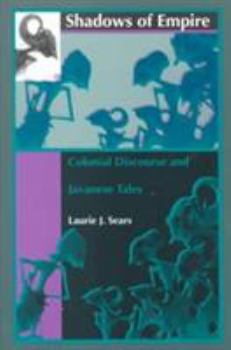Shadows of Empire: Colonial Discourse and Javanese Tales
Select Format
Select Condition 
Book Overview
Shadows of Empire explores Javanese shadow theater as a staging area for negotiations between colonial power and indigenous traditions. Charting the shifting boundaries between myth and history in Javanese Mahabharata and Ramayana tales, Laurie J. Sears reveals what happens when these stories move from village performances and palace manuscripts into colonial texts and nationalist journals and, most recently, comic books and novels. Historical,...
Format:Paperback
Language:English
ISBN:0822316978
ISBN13:9780822316978
Release Date:March 1996
Publisher:Duke University Press
Length:376 Pages
Weight:1.40 lbs.
Dimensions:1.1" x 6.1" x 9.2"
Customer Reviews
1 rating
Useful perspective on wayang
Published by Thriftbooks.com User , 14 years ago
I have just finished reading this work and thoroughly enjoyed it. With all respect to the other reviewer (whose other incisive and insightful reviews I have read), I believe that this book deserves a more favourable rating. In her work the author is not discussing the 'Mahabharata' per se but rather how the Javanese form of this Indian epic has been used through the 'wayang kulit' or shadow play. The author focuses mainly on the 'wayang purwa'repertoire yet does include other useful material such as the 'Murwakala' story which is used at the 'ruwatan' exorcism, etc. The author illustrates how, since Dutch occupation, the wayang has been used to make social comment. Invariably, such comment took place at a specific part of the performance called the 'gara-gara', in which the 'panakawan' or clown characters appear. Although this section does not belong to the Indian epic, it is the part that lends itself to satire and invariably when the 'dalang' (or Javanese 'dhalang'), i.e. puppeteer could voice his own political/social views. During the Dutch colonial period, the revolution for independence from the westerners could be seen in the struggle between the Pandhawa and Korawa brothters which underlies the Mahabharata: the fight between the good and just and the evil and unjust. It is perhaps surprising that the author does not refer to other forms of wayang, especially 'wayang suluh', which is centred around the theme of the struggle for independence from the Dutch. One can infer from these pages that sadly the dalang's use of expression to make positive social comment on behalf of the people became abused by the dalang themselves.Though the author mentions several contemporary dalang, whom she describes in glowing terms as most skliful artists, it seems that some of them have just degenerated into servile mouthpieces of the government. Rather that use their art to make social comment and expose injustice, etc. they were often employed to communicate the propaganda of the dictator Soeharto who sponsored them. By contrast, the Greek 'karagiozis' shadow theatre (though a less sophisticated form than wayang), has always been a mouthpiece of the people, not of the powerful establishment! The author's contibution to the study of wayang is also important in her detailed discussion about the various categories of 'lakon' or plots/stories. Her research is almost unimpeachable and her rich bibliography includes works in Dutch, Indonesian and Javanese. An extensive glossary is also provided, as well as copious foot notes and a comprehensive index.





